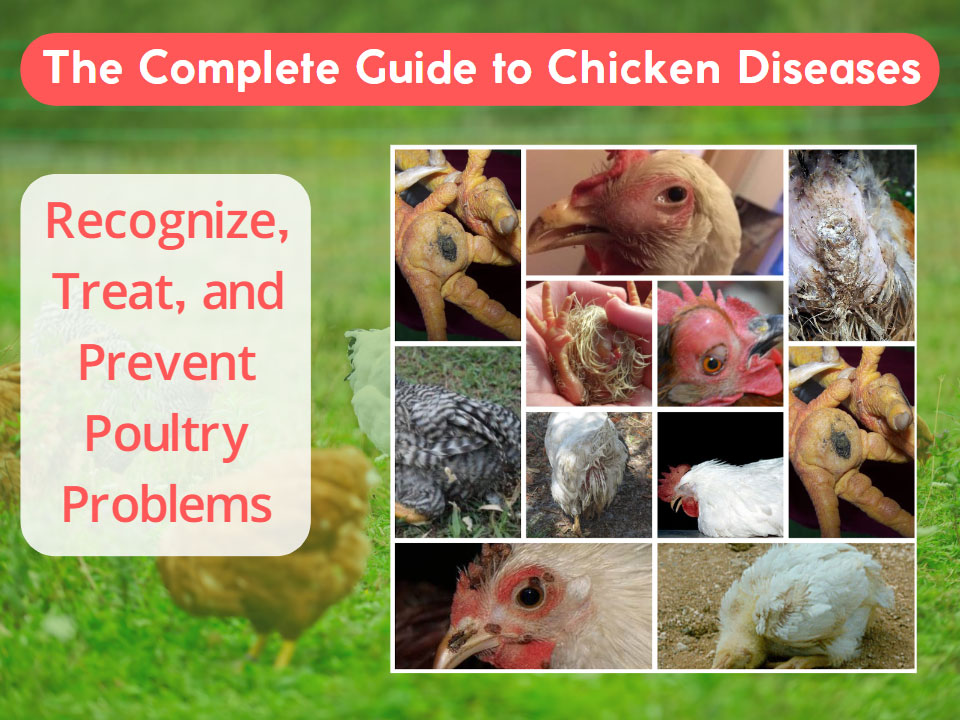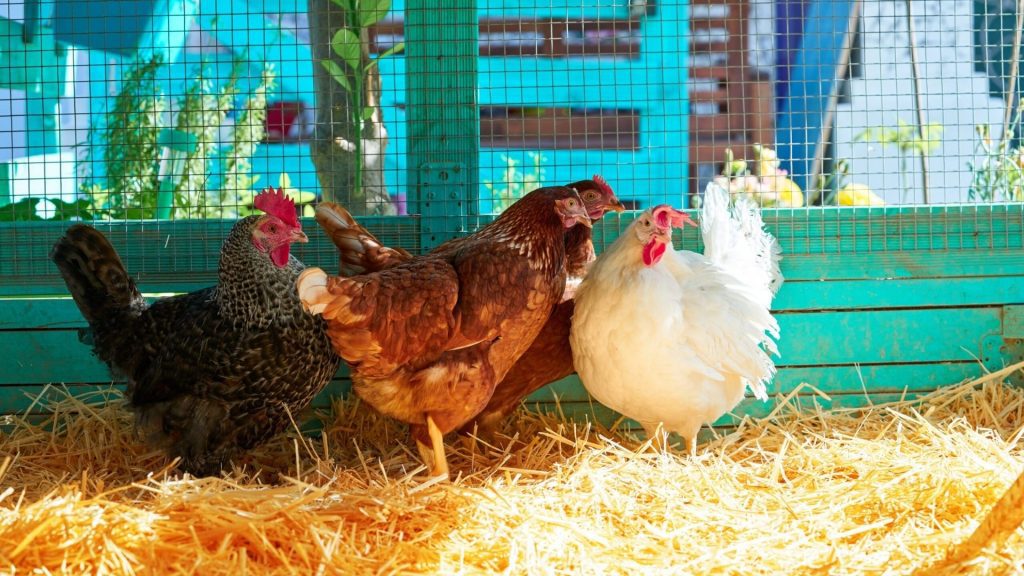Chicken disease refers to the abnormal condition, sickness, or illness of your chicken. Viruses, Chlamydia, Bacteria, Fungi, and many more factors cause different diseases. Some major poultry diseases are Avian Influenza, Exotic Newcastle disease, Pullorum Typhoid, Colibacillosis, Fowl Cholera, Ulcerative Enteritis, etc.
All these diseases are dangerous. Once a hen is affected by the disease, it can spread in the entire flock through infectious agents, stress, environmental conditions, etc. So, be aware of this to prevent the spreading of disease.
In this article, we will discuss all those major diseases that can attack your bird. Go through the details and learn what the symptoms of this disease are and how they spread. So, let’s dive into the discussion:
What Is Chicken Disease?
The disease is the abnormal condition of your chicken when the birds become sick. Basic weaknesses, infection, or environmental stress cause chicken disease. Seeing some particular symptoms or signs, you can define the disease. When the chickens become sick, they can’t function properly.
The bird’s overall condition is referred to as health at a given point in time. The disease makes the chicken’s health vulnerable and weak. Therefore it can result in reduced quality and poor productivity of the affected animals. Sometimes you can lose one bird or the entire flock due to a sudden bad disease.

How Do Chicken Diseases Spread?
A certain disease can destroy your entire poultry flock just by spreading among the flock. But you can reduce this loss to a great extent if you know how the disease spreads and how you can stop it from spreading.
Spreading the diseases among the chickens can cause widespread financial hardship for both the small and commercial flock owners. However, usually, chicken disease spreads for the following reasons:
- Indirect contact with the people, contaminated equipment, or environment
- Direct connection to the infected manure or direct bird-to-bird contact
- Rodents, wild animals, insects, or other vectors can spread the disease
Types Of Chicken Disease
Different types of diseases can affect your poultry flock. First off, we are making a list here so that you can get a quick idea about the variety of diseases. So, take a look at it:
|
Disease Caused by Viruses |
|
|
Diseases Caused by Chlamydia |
|
|
Diseases Caused by Bacteria |
|
|
Diseases Caused By Fungi |
|
|
Disease Caused By External Parasites |
|
|
Diseases Caused By Protozoa |
|
|
Diseases Caused By Metabolic Disorders |
|
|
Diseases Caused By Internal Parasites |
|
|
Diseases Caused By Environmental Factors |
|
|
Diseases Caused By Mycoplasmas |
|
Now, below we will discuss some of the major diseases in detail. Let’s go through it:
Chicken Disease, Poultry Diseases – All Details
Some diseases have higher consequences and greater effects on the chicken flock than others. And this type of disease is called the high devastation rate. The flock owners can ensure their bird’s good health and can protect the birds by knowing about these diseases.
Now we will explain all these diseases with their symptoms. Let’s go through it:
1. Avian Influenza
Avian Influenza, or AI, is a chicken’s respiratory disease. A wide variety of chickens can get infected by the AIl viruses, like turkeys, ducks, chickens, pheasants, geese, ducks, etc. Depending on the severity of the illness, you can define the type A influenza virus.
Moreover, based on the severity of the disease, you can classify the highly pathogenic and low pathogenic AI viruses.
- Highly Pathogenic Avian Influenza (HPAI): This is the disease’s most fatal and infectious form. Once this disease is established in one bird suddenly, it can spread from flock to flock and bird to bird. This is so influential that 1 gram of contaminated manure can rapidly infect 1 million birds. HPAI results in high death losses and severe illness.
- Low Pathogenic Avian Influenza (LPAI): LPAI causes few clinical signs in the chicken flock. Hens with LPAI most of the time don’t show any sickness signs and appear healthy. Seeing some respiratory and slight facial swelling symptoms, you can define the LPAI.
LPAI and HPAI are the two common forms of Avian Influenza. Now the question is how this virus spread among the birds. Direct contact between the infected and healthy chicken through the respiratory feces and secretions spreads the AI virus. Other ways of spreading this disease are:
- Birds expose to wild waterfowl
- Chicken’s illegal international movement
- Smuggling of poultry products and poultry
- Direct bird-to-bird contact
2. Exotic Newcastle Disease
Another fatal viral and contagious disease is Exotic Newcastle Disease. And it affects all bird species. Globally this disease is the most infectious. This virus is so dangerous that many birds diet without presenting any signs of disease.
If this disease attacks the un-vaccinated poultry flocks, then 100% can also be the death rate. Even vaccinated poultry can suffer from this disease. END (Exotic Newcastle Disease) spread mainly through the following:
- When the infected birds come in contact with the healthy birds
- Clothing, shoes, vehicles, and equipment are virus-bearing materials. The exposure of these materials
- Commercially raised chickens can rapidly spread this disease among the healthy flock
The Clinical Signs of Exotic Newcastle Disease
- Nasal discharge, sneezing, coughing
- Dropping wings, muscular tremors, circling, head and neck twisting, paralysis, etc.
- Thin-shelled eggs production
- Infected flock’s sudden and high death rate
3. Pullorum Typhoid Disease
Pullorum-Typhoid is another bad disease, and chickens are very vulnerable to infection. Turkeys mostly suffer from this disease. The roosters and hens can carry bacteria without showing any outward infection signs.
However, sometimes the adult bird can show swelling signs, which indicates Pullorum-typhoid contamination. PT (Pullorum typhoid) mainly spreads in the following ways:
- Directly through the egg, primarily transmitted from the hen to the young chicks
- Through the infected chicken’s respiratory and digestive secretions, it can also spread
Signs of Pullorum Typhoid Disease
- Swelling in adult bird’s joints
- Chicks and pullet’s physical appearance like the dropping wing, drowsiness, distorted body appearance, etc.
- Internal organ’s severe lesions
- After hatching in the first three weeks, the death rate is very high
4. Colibacillosis (Coliform Infections)
The Escherichia coli organism strains often cause coliform infections within your flock. The chronic nature of mild infections results in low mortality and morbidity. On the contrary, severe acute infections result in sudden and high mortality. However, this disease spread rapidly due to the following causes:
- An air sac infection can result in respiratory disease
- Generalized infections cause septicemic disease
5. Fowl Cholera
For turkeys, the most dangerous infectious disease is fowl cholera. The host range is quite extensive and includes turkeys, waterfowl, chickens, pheasants, sparrows, pigeons, and other flying birds. Pasteurella multocida is the causative organism of this disease.
The organism in droppings can sustain for at least one month. Whereas in the soil, the organism can sustain for 2-3 months, and in decaying carcasses, it sustains for three months. However, the major source of infection of this disease are:
- The body excreta of affected chickens contaminate the water, soil, feed, etc.
- Contaminated water supplies like ponds, surface tanks, lakes, streams, and ponds
- Contaminated equipment and shoes result in mechanical transmission
6. Ulcerative Enteritis
Ulcerative enteritis is a chronic or acute infection for chickens, game birds, turkeys, quail, and other domestic fowl. This disease can cause high death losses. The major reason for this disease is a spore-forming bacterial rod, clostridium colinum. This disease spreads for the following reasons:
- Healthy birds get infected from the carrier or sick bird’s droppings.
- Under varying environmental conditions, the infection spreads quickly.
7. Fowl Typhoid
Another contagious and infectious bacterial poultry disease is fowl typhoid. Usually, it is acute, but sometimes it can be chronic. This disease affects almost every type of bird, including turkeys, pigeons, chickens, pheasants, ducks, and other game birds.
The salmonella gallinarum bacteria are the main cause of it. Just like the Pullorum disease, the transmission method of it is the same, including egg transmission. However, the more prevalent one is the mechanical transmission of Pullorum disease. This disease can affect birds of any age. But young adult chickens usually become affected by it the most.
8. Infectious Coryza
The specific respiratory disease in poultry is infectious Coryza. Most often, this disease attack the semi-mature or adult birds. This is a chronic and slow-spreading disease that one time affects only several chickens. But sometimes, it can spread rapidly and affect the higher percentage of birds in your flock. However, the infectious Croyza is not that widespread.
The Hemophilus gallinarum bacteria cause this disease. Usually, the outbreak of this disease happens due to the virus carrier bird’s introduction into the flock.
Symptoms of Infectious Coryza
- Edematous swelling of the face
- Swollen sinuses
- Nasal discharge
- Water discharge from the eye etc.
9. Erysipelas
Another bacterial disease is Erysipelas. The Erysipelothrix insidious cause this disease. It affects different species of birds like ducks and geese, chickens, turkeys, etc. This is susceptible to infection, and the infected bird can spread this disease among the entire flock.
During the fall and winter, most often, the Erysipelas outbreaks. This disease can spread among your chicken’s flock in the following ways:
- Infectious birds come in contact with the healthy chicken flock
- Rodent or wild animals spread the disease
What To Do If You Recognize The Disease In Your Flock
Once a disease attack one of your hens, it can quickly spread through the entire flock. Therefore whenever you recognize that your birds are suffering from disease, you should take a step immediately. Initially, you can do the following to prevent illness:
i) Immediately Take Steps To Reduce The Disease Spread
By reducing the spreading of disease, you can reduce the risk of greater loss. You have to take the following precautions to prevent the spreading of illness within your flocks:
- Keep the sick bird separate from the entire flock
- As soon as contact with a veterinarian and till then restrict the equipment or person to get in touch with the flock
- After getting contact with the infected bird, you must disinfect and shower your footwear and clothing
ii) Contact The Veterinarian
Sometimes seeing some symptoms with the birds, you may get confused because some diseases have similar symptoms. Whenever you go through such a situation, you should take your local veterinarian’s help to diagnose all these illnesses.
iii) Contact The Animal Disease Diagnostic Laboratory
The laboratory authority will help you diagnose the disease in your flock by performing the necessary tests.
Also Read: How To Choose The Right Materials For A Long-Lasting And Easy-to-Maintain Chicken Coop
Frequently Asked Questions
What are the most common poultry diseases?
The most common diseases that affect the poultry flock are avian influenza, Newcastle disease, Pullorum Typhoid, foul cholera, etc. Some other diseases are parasitism, avian encephalomyelitis, viral diseases, infectious bronchitis, etc.
What are the 5 causes of diseases in poultry?
Nutritional deficiencies, physical stress, poisons, exposure to disease-carrying birds, and extreme temperature are the most common five causes. All these factors create and spread disease in your poultry flock.
How do you control chicken disease?
To control chicken disease, you have to vaccinate your birds. Also, you need to control the parasites that spread disease. You must identify and treat the sick birds and separate the multi-age flocks.
Final Thoughts
Several chicken diseases can attack your birds and destroy your entire flock. Usually, viruses, bacteria, fungi and other parasites cause this poultry disease. Therefore to prevent the attacks and spread of disease, you need to take some preventive actions. Ensure you give the vaccine to every bird in your flock and control the parasite in your coop.
We already discussed all the major details about the disease. Now, if you have any other queries, comment in the comment box, and soon we will reply.
Raising Chickens 101: A Beginner’s Guide
Get started in chicken raising with our expert-approved guide. From building a coop to hatching eggs, you’ll learn all the essential information you need to know. Topics include selecting breeds, caring for chicks, increasing egg production, and more. We also cover chicken feeds, behavior, disease prevention, and essential vitamins and minerals. Follow this guide for a successful and fulfilling experience.
Want to learn more about chicken raising? Check out our beginner’s guide below for even more tips and information:



